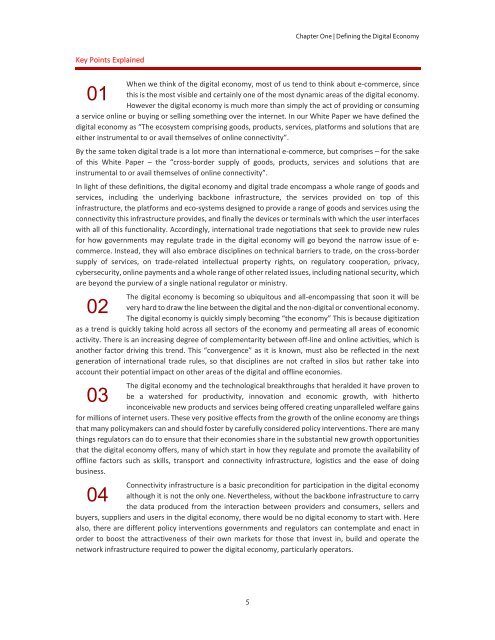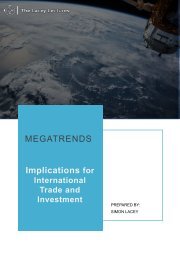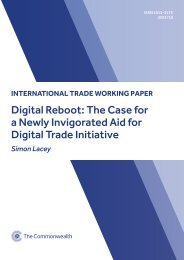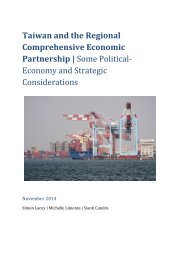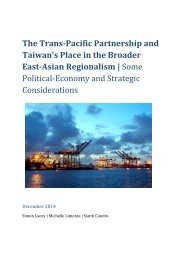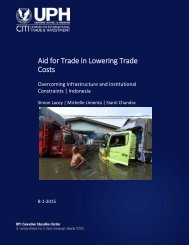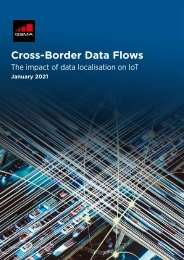White Paper Trade Rules and the Digital Economy Key Points and Findings
This synopsis document summarizes and articulates the key points and findings from the much longer 2017 White Paper on Trade Rules for the Digital Economy.
This synopsis document summarizes and articulates the key points and findings from the much longer 2017 White Paper on Trade Rules for the Digital Economy.
- No tags were found...
You also want an ePaper? Increase the reach of your titles
YUMPU automatically turns print PDFs into web optimized ePapers that Google loves.
Chapter One | Defining <strong>the</strong> <strong>Digital</strong> <strong>Economy</strong><br />
<strong>Key</strong> <strong>Points</strong> Explained<br />
01<br />
When we think of <strong>the</strong> digital economy, most of us tend to think about e‐commerce, since<br />
this is <strong>the</strong> most visible <strong>and</strong> certainly one of <strong>the</strong> most dynamic areas of <strong>the</strong> digital economy.<br />
However <strong>the</strong> digital economy is much more than simply <strong>the</strong> act of providing or consuming<br />
a service online or buying or selling something over <strong>the</strong> internet. In our <strong>White</strong> <strong>Paper</strong> we have defined <strong>the</strong><br />
digital economy as “The ecosystem comprising goods, products, services, platforms <strong>and</strong> solutions that are<br />
ei<strong>the</strong>r instrumental to or avail <strong>the</strong>mselves of online connectivity”.<br />
By <strong>the</strong> same token digital trade is a lot more than international e‐commerce, but comprises – for <strong>the</strong> sake<br />
of this <strong>White</strong> <strong>Paper</strong> – <strong>the</strong> “cross‐border supply of goods, products, services <strong>and</strong> solutions that are<br />
instrumental to or avail <strong>the</strong>mselves of online connectivity”.<br />
In light of <strong>the</strong>se definitions, <strong>the</strong> digital economy <strong>and</strong> digital trade encompass a whole range of goods <strong>and</strong><br />
services, including <strong>the</strong> underlying backbone infrastructure, <strong>the</strong> services provided on top of this<br />
infrastructure, <strong>the</strong> platforms <strong>and</strong> eco‐systems designed to provide a range of goods <strong>and</strong> services using <strong>the</strong><br />
connectivity this infrastructure provides, <strong>and</strong> finally <strong>the</strong> devices or terminals with which <strong>the</strong> user interfaces<br />
with all of this functionality. Accordingly, international trade negotiations that seek to provide new rules<br />
for how governments may regulate trade in <strong>the</strong> digital economy will go beyond <strong>the</strong> narrow issue of e‐<br />
commerce. Instead, <strong>the</strong>y will also embrace disciplines on technical barriers to trade, on <strong>the</strong> cross‐border<br />
supply of services, on trade‐related intellectual property rights, on regulatory cooperation, privacy,<br />
cybersecurity, online payments <strong>and</strong> a whole range of o<strong>the</strong>r related issues, including national security, which<br />
are beyond <strong>the</strong> purview of a single national regulator or ministry.<br />
The digital economy is becoming so ubiquitous <strong>and</strong> all‐encompassing that soon it will be<br />
02 very hard to draw <strong>the</strong> line between <strong>the</strong> digital <strong>and</strong> <strong>the</strong> non‐digital or conventional economy.<br />
The digital economy is quickly simply becoming “<strong>the</strong> economy” This is because digitization<br />
as a trend is quickly taking hold across all sectors of <strong>the</strong> economy <strong>and</strong> permeating all areas of economic<br />
activity. There is an increasing degree of complementarity between off‐line <strong>and</strong> online activities, which is<br />
ano<strong>the</strong>r factor driving this trend. This “convergence” as it is known, must also be reflected in <strong>the</strong> next<br />
generation of international trade rules, so that disciplines are not crafted in silos but ra<strong>the</strong>r take into<br />
account <strong>the</strong>ir potential impact on o<strong>the</strong>r areas of <strong>the</strong> digital <strong>and</strong> offline economies.<br />
The digital economy <strong>and</strong> <strong>the</strong> technological breakthroughs that heralded it have proven to<br />
03 be a watershed for productivity, innovation <strong>and</strong> economic growth, with hi<strong>the</strong>rto<br />
inconceivable new products <strong>and</strong> services being offered creating unparalleled welfare gains<br />
for millions of internet users. These very positive effects from <strong>the</strong> growth of <strong>the</strong> online economy are things<br />
that many policymakers can <strong>and</strong> should foster by carefully considered policy interventions. There are many<br />
things regulators can do to ensure that <strong>the</strong>ir economies share in <strong>the</strong> substantial new growth opportunities<br />
that <strong>the</strong> digital economy offers, many of which start in how <strong>the</strong>y regulate <strong>and</strong> promote <strong>the</strong> availability of<br />
offline factors such as skills, transport <strong>and</strong> connectivity infrastructure, logistics <strong>and</strong> <strong>the</strong> ease of doing<br />
business.<br />
Connectivity infrastructure is a basic precondition for participation in <strong>the</strong> digital economy<br />
04 although it is not <strong>the</strong> only one. Never<strong>the</strong>less, without <strong>the</strong> backbone infrastructure to carry<br />
<strong>the</strong> data produced from <strong>the</strong> interaction between providers <strong>and</strong> consumers, sellers <strong>and</strong><br />
buyers, suppliers <strong>and</strong> users in <strong>the</strong> digital economy, <strong>the</strong>re would be no digital economy to start with. Here<br />
also, <strong>the</strong>re are different policy interventions governments <strong>and</strong> regulators can contemplate <strong>and</strong> enact in<br />
order to boost <strong>the</strong> attractiveness of <strong>the</strong>ir own markets for those that invest in, build <strong>and</strong> operate <strong>the</strong><br />
network infrastructure required to power <strong>the</strong> digital economy, particularly operators.<br />
5


